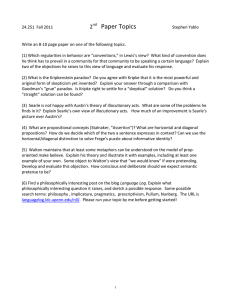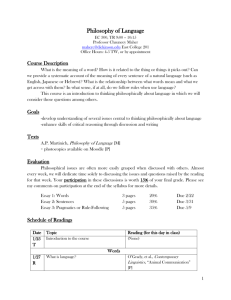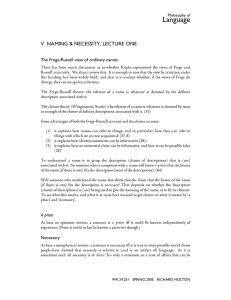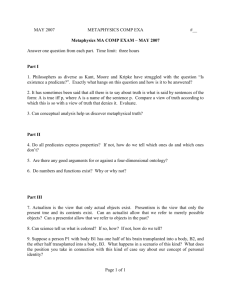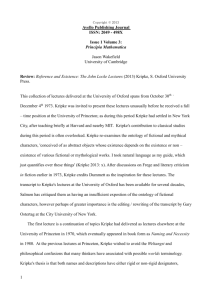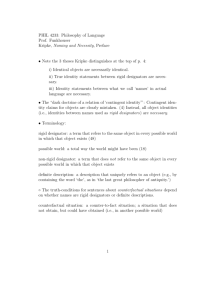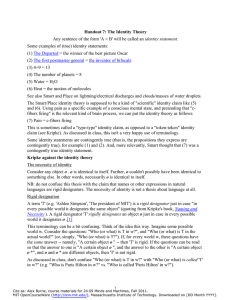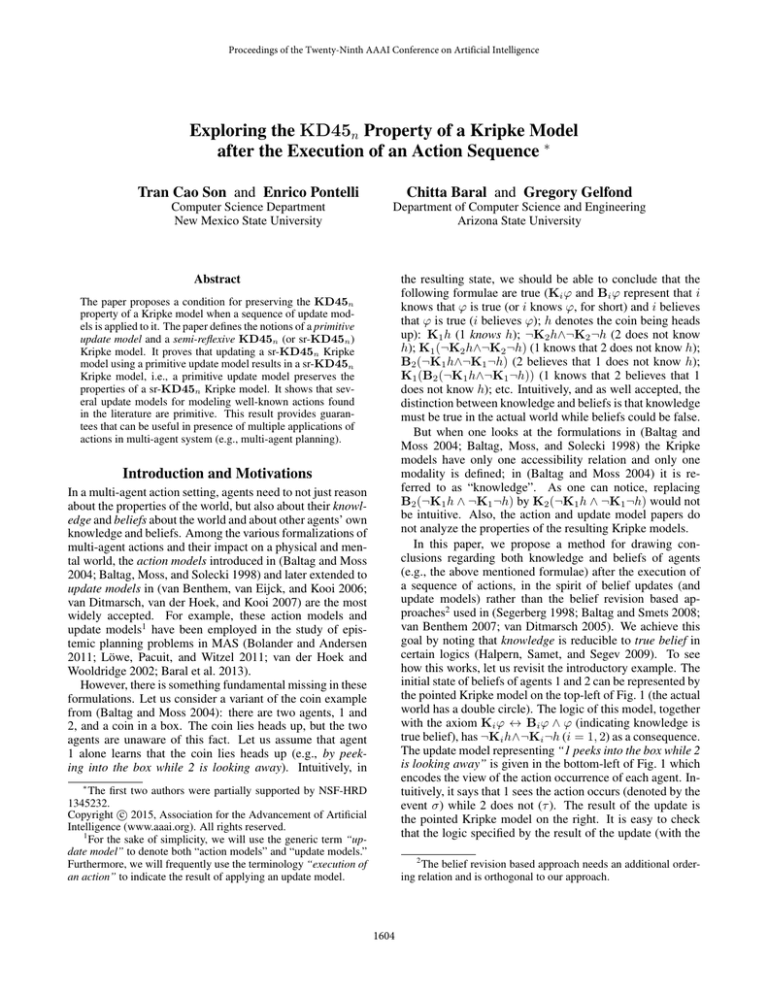
Proceedings of the Twenty-Ninth AAAI Conference on Artificial Intelligence
Exploring the KD45n Property of a Kripke Model
after the Execution of an Action Sequence ∗
Tran Cao Son and Enrico Pontelli
Chitta Baral and Gregory Gelfond
Computer Science Department
New Mexico State University
Department of Computer Science and Engineering
Arizona State University
the resulting state, we should be able to conclude that the
following formulae are true (Ki ϕ and Bi ϕ represent that i
knows that ϕ is true (or i knows ϕ, for short) and i believes
that ϕ is true (i believes ϕ); h denotes the coin being heads
up): K1 h (1 knows h); ¬K2 h∧¬K2 ¬h (2 does not know
h); K1 (¬K2 h∧¬K2 ¬h) (1 knows that 2 does not know h);
B2 (¬K1 h∧¬K1 ¬h) (2 believes that 1 does not know h);
K1 (B2 (¬K1 h∧¬K1 ¬h)) (1 knows that 2 believes that 1
does not know h); etc. Intuitively, and as well accepted, the
distinction between knowledge and beliefs is that knowledge
must be true in the actual world while beliefs could be false.
But when one looks at the formulations in (Baltag and
Moss 2004; Baltag, Moss, and Solecki 1998) the Kripke
models have only one accessibility relation and only one
modality is defined; in (Baltag and Moss 2004) it is referred to as “knowledge”. As one can notice, replacing
B2 (¬K1 h ∧ ¬K1 ¬h) by K2 (¬K1 h ∧ ¬K1 ¬h) would not
be intuitive. Also, the action and update model papers do
not analyze the properties of the resulting Kripke models.
In this paper, we propose a method for drawing conclusions regarding both knowledge and beliefs of agents
(e.g., the above mentioned formulae) after the execution of
a sequence of actions, in the spirit of belief updates (and
update models) rather than the belief revision based approaches2 used in (Segerberg 1998; Baltag and Smets 2008;
van Benthem 2007; van Ditmarsch 2005). We achieve this
goal by noting that knowledge is reducible to true belief in
certain logics (Halpern, Samet, and Segev 2009). To see
how this works, let us revisit the introductory example. The
initial state of beliefs of agents 1 and 2 can be represented by
the pointed Kripke model on the top-left of Fig. 1 (the actual
world has a double circle). The logic of this model, together
with the axiom Ki ϕ ↔ Bi ϕ ∧ ϕ (indicating knowledge is
true belief), has ¬Ki h∧¬Ki ¬h (i = 1, 2) as a consequence.
The update model representing “1 peeks into the box while 2
is looking away” is given in the bottom-left of Fig. 1 which
encodes the view of the action occurrence of each agent. Intuitively, it says that 1 sees the action occurs (denoted by the
event σ) while 2 does not (τ ). The result of the update is
the pointed Kripke model on the right. It is easy to check
that the logic specified by the result of the update (with the
Abstract
The paper proposes a condition for preserving the KD45n
property of a Kripke model when a sequence of update models is applied to it. The paper defines the notions of a primitive
update model and a semi-reflexive KD45n (or sr-KD45n )
Kripke model. It proves that updating a sr-KD45n Kripke
model using a primitive update model results in a sr-KD45n
Kripke model, i.e., a primitive update model preserves the
properties of a sr-KD45n Kripke model. It shows that several update models for modeling well-known actions found
in the literature are primitive. This result provides guarantees that can be useful in presence of multiple applications of
actions in multi-agent system (e.g., multi-agent planning).
Introduction and Motivations
In a multi-agent action setting, agents need to not just reason
about the properties of the world, but also about their knowledge and beliefs about the world and about other agents’ own
knowledge and beliefs. Among the various formalizations of
multi-agent actions and their impact on a physical and mental world, the action models introduced in (Baltag and Moss
2004; Baltag, Moss, and Solecki 1998) and later extended to
update models in (van Benthem, van Eijck, and Kooi 2006;
van Ditmarsch, van der Hoek, and Kooi 2007) are the most
widely accepted. For example, these action models and
update models1 have been employed in the study of epistemic planning problems in MAS (Bolander and Andersen
2011; Löwe, Pacuit, and Witzel 2011; van der Hoek and
Wooldridge 2002; Baral et al. 2013).
However, there is something fundamental missing in these
formulations. Let us consider a variant of the coin example
from (Baltag and Moss 2004): there are two agents, 1 and
2, and a coin in a box. The coin lies heads up, but the two
agents are unaware of this fact. Let us assume that agent
1 alone learns that the coin lies heads up (e.g., by peeking into the box while 2 is looking away). Intuitively, in
∗
The first two authors were partially supported by NSF-HRD
1345232.
c 2015, Association for the Advancement of Artificial
Copyright Intelligence (www.aaai.org). All rights reserved.
1
For the sake of simplicity, we will use the generic term “update model” to denote both “action models” and “update models.”
Furthermore, we will frequently use the terminology “execution of
an action” to indicate the result of applying an update model.
2
The belief revision based approach needs an additional ordering relation and is orthogonal to our approach.
1604
A logic Λ is a set of formulae in LAG (L1 , . . . , Lk ) that
(i) contains all propositional tautologies; (ii) is closed under
modus ponens; and (iii) is closed under substitution. A logic
is normal if it contains the axioms Li (ϕ → ψ) → (Li ϕ →
Li ψ), referred to as (KLi ) for i = 1, . . . , k, and is closed
under generalization, i.e., if it contains ϕ, then it will also
contain Li ϕ. A logic generated by a set A of formulae (axioms) is the smallest normal logic containing A. For two sets
of axioms Λ1 and Λ2 , Λ1 + Λ2 is the smallest normal logic
containing Λ1 and Λ2 .
Let AG = {1, 2, . . . , n} be a set of n agents. Each
agent i is associated with a belief operator Bi and a knowledge operator Ki . Our focus is the logic of belief, called
KD45n , over the language LAG (B1 , . . . , Bn ) that is generated by the following axioms: (D) Bi ϕ→¬Bi ¬ϕ, (4)
Bi ϕ→Bi Bi ϕ, and (5) ¬Bi ϕ→Bi ¬Bi ϕ where i ∈ AG and
ϕ ∈ LAG (B1 , . . . , Bn ). It is shown in (Halpern, Samet, and
Segev 2009) that knowledge can be reduced to true belief in
KD45n . More specifically, the knowledge modality Ki is
reducible to Bi in KD45n by the axiom Ki ϕ ↔ (Bi ϕ∧ϕ).
This also means that we can remove the knowledge modal
operator from the language yet still be able to derive conclusions about knowledge of agents.
A Kripke frame F is a tuple S, K1 , . . . , Kn where S is a
set of worlds (or points) and Ki ⊆ S × S for i ∈ AG, called
the accessibility relation for i. A Kripke model M based on
the frame F is a pair (F, π), where π : F[S] → 2P is a
function that associates an interpretation of P to each world
in F. For M = (F, π), M[π] denotes π and M[S] and
M[i] denote the set of worlds S and Ki of F, respectively.
A pointed Kripke model (or p-model) is a pair (M, s),
where M is a Kripke model and s ∈ M[S], called the actual world. We will often represent a Kripke model M by
a directed graph whose nodes are the worlds in M[S] and
the labeled edges are the members of M[i]. The name of a
world is drawn next to the node and the interpretation associated to it is given by the label of the node. Entailment of
formulae in LAG (L1 , . . . , Ln ) in a p-model is defined next.
axiom Ki ϕ ↔ Bi ϕ ∧ ϕ), entails the formulae in our initial
example (e.g., 1 knows h, 1 knows that 2 believes that 1 does
not knows h, etc.).
Figure 1: Knowledge as true belief
With our emphasis on distinguishing belief and knowledge, we also focus on what properties these modalities
have and how they are preserved when a sequence of actions is executed. A limited attention to this has been paid
in the literature—(Herzig, Lang, and Marquis 2005) being
an exception. The focus has been mostly on properties of
knowledge or beliefs of the agents after a single update—
e.g., (Baltag and Moss 2004) shows that all agents have the
correct knowledge about a formula ϕ after the execution of a
public announcement. On the other hand, the more general
question of whether the fundamental properties of beliefs
(i.e., KD45n ) and knowledge (i.e., S4.4n ) are preserved
by interesting classes of actions has been rarely touched.
In this paper, we provide a feasible approach for drawing conclusions about the knowledge and beliefs of agents
after the execution of an arbitrary sequence of actions, i.e.,
after updating a Kripke model by a sequence of update models. This is particularly important in applications such as in
security (e.g., exchanging a key between a group of agents
without revealing it to outsiders) and multi-agent planning
(e.g., executing an attack plan while making the enemy believe otherwise). To this end, we present a sufficient syntactic condition on update models and Kripke models under
which the KD45n property of the Kripke models is preserved after application of an update model. We observe
that this result could be viewed as an extension of the result
in (Halpern, Samet, and Segev 2009) to a dynamic setting.
We demonstrate that update models found in the literature
for representing several well-known actions satisfy the proposed sufficient condition. In the process, we identify some
critical issues that need to be taken into consideration when
update models are used.
Definition 1 Given a formula ϕ and a p-model (M, s):
• (M, s) |= ϕ if M[π](s) |= ϕ and ϕ is an atomic formula;
• (M, s) |= Li ϕ if, for each t s.t. (s, t) ∈ Ki , (M, t) |= ϕ;
• (M, s) |= ¬ϕ if (M, s) |= ϕ;
• (M, s) |= ϕ1 → ϕ2 if (M, s) |= ¬ϕ1 or (M, s) |= ϕ2 .
M |= ϕ denotes that (M, s) |= ϕ for each s ∈ M[S]. ϕ
is said to be valid in a frame F if M |= ϕ for every Kripke
model M based on F. The set of valid formulae in F is
denoted with T h(F). For a class of frames S, T h(S) is the
set of formulae valid in each frame in S. A logic Λ is sound
for S if Λ ⊆ T h(S); it is complete for S if T h(S) ⊆ Λ. For
a logic Λ, a frame F is said to be a Λ frame if Λ ⊆ T h(F).
A relation R ⊆ S × S is reflexive iff (u, u) ∈ R for
every u ∈ S; serial iff for every u ∈ S there exists some
v ∈ S such that (u, v) ∈ R; transitive iff (u, v) ∈ R and
(v, z) ∈ R imply that (u, z) ∈ R; Euclidean iff (u, v) ∈ R
and (u, z) ∈ R imply that (v, z) ∈ R.
Frames can be characterized by the properties of their
accessibility relations. It is known that a frame F =
(S, K1 , . . . , Kn ) is a KD45n frame iff for every i =
Background
Logics of Knowledge and Belief. We consider the standard logics of knowledge and belief with a set of modalities L1 , . . . , Lk and use the notation from (Halpern, Samet,
and Segev 2009). We use a collection P of propositions to describe the properties that characterize the world.
LAG (L1 , . . . , Lk ) is the set of formulae defined as follows.
Each p ∈ P is a formula. If ϕ and ψ are formulae then so
are ¬ϕ, ϕ → ψ, and Li ϕ (i = 1, . . . , k). The connectives
∨, ∧, ↔ can be defined in terms of ¬ and →. An atomic
formula is a formula that does not contain a modal operator.
1605
1, . . . , n, Ki is serial, transitive, and Euclidean. A Kripke
model M = (F, π) is said to be a KD45n model if its
frame F is a KD45n frame.
• ((s, τ ), (s , τ )) ∈ M [i] iff (s, τ ), (s , τ ) ∈ M [S],
(s, s ) ∈ M[i] and (τ, τ ) ∈ Ri ;
• ∀f ∈ P.[M [π]((s, τ ))|=f iff f →ϕ∈sub(τ ), (M, s)|=ϕ].
Update Models. Update models describe transformations
of (pointed) Kripke models according to a predetermined
pattern. An update model uses structures similar to pointed
Kripke models and they describe the effects of a transformation on p-models using an update operator (Baltag and Moss
2004; van Benthem, van Eijck, and Kooi 2006).
A set {p → ϕ | p ∈ P, ϕ ∈ LAG (B1 , . . . , Bn )}
is called an LAG (B1 , . . . , Bn )-substitution (or substitution,
for short). For each substitution sub and each p ∈ P, we
assume that sub contains exactly one formula p → ϕ. For
simplicity of the presentation, we often omit p → p in a
substitution. SU BLAG denotes the set of all substitutions.
A substitution is used to encode changes caused by an action occurrence. A formula p → ϕ in a substitution states
the condition (ϕ) under which p will become true. For example, the action of flipping a coin can be represented by
the substitution {h → ¬h} which says that h (the coin lies
head up) is true iff ¬h (the coin lies head down) were true.
The update of a p-model (M, s) given an update template
(Σ, Γ) is a set of p-models, denoted by (M, s) ⊗ (Σ, Γ),
where (M , s )∈(M, s) ⊗ (Σ, Γ) iff it holds that M =M ⊗
Σ and s = (s, τ ) where τ ∈ Γ and s ∈ M [S].
Intuitively, the set (M, s) ⊗ (Σ, Γ) is the set of p-models
encoding the result of the execution of the action, which is
represented by the update template (Σ, Γ), in the p-model
(M, s). It is easy to see that the p-model on the right of
Fig. 1 is the unique element of (M0 , s) ⊗ (Σ, {σ}) where
M0 = ({s, u}, K1 , K2 , π) with K1 = K2 = {(x, y) |
x, y ∈ {s, u}}, π(s)(h) = true, and π(u)(h) = f alse.
We will often depict an update instance via a graph with
rectangles representing events (double rectangles for designated events), and labeled edges representing each Ri .
Definition 2 (Update Model) An update model Σ is a tuple
Σ, R1 , . . . , Rn , pre, sub where
• Σ is a set, whose elements are called events;
• each Ri is a binary relation on Σ;
• pre : Σ → LAG (B1 , . . . , Bn ) is a function mapping
each event a ∈ Σ to a formula in LAG (B1 , . . . , Bn ); and
• sub : Σ → SU BLAG .
An update instance ω is a pair (Σ, e) where Σ is an update
model and e ∈ Σ (or a designated event). An update template is a pair (Σ, Γ) where Σ is an update model with the
set of events Σ and Γ ⊆ Σ.
In this section, we present a sufficient condition for the
maintenance of the KD45n property of a Kripke model
M after the application of a sequence of update models
Σ1 , . . . , Σk . The next lemma shows that updating a p-model
by an update model does preserve reflexivity, transitivity,
and Euclidicity of a Kripke model if the update model also
satisfies the corresponding property. Observe that, since we
are exploring structural properties of the frames underlying updated models, we will not emphasize the designated
events and the actual world whenever it is unnecessary.
Maintaining KD45n via Update Models
Lemma 1 Let M = (F, π) be a Kripke model and Σ =
Σ, R1 , . . . , Rn , pre, sub be an update model. Then, the
following properties hold:
• if M and Σ are reflexive then M ⊗ Σ is reflexive;
• if M and Σ are transitive then M ⊗ Σ is transitive; and
• if M and Σ are Euclidean then M ⊗ Σ is Euclidean.
Intuitively, an update model represents different views of an
action occurrence, associated to the observability of agents.
Each view is represented by an event in Σ. The designated
event in an update instance is the one that agents who are
aware of the action occurrence will observe. Templates extend the notion of instance to capture non-deterministic actions and other non-simple actions. The relation Ri describes agent i’s uncertainty about an action occurrence—
i.e., if (σ, τ ) ∈ Ri and event σ is performed, then agent i
may believe that event τ is executed instead. pre defines the
action precondition and sub specifies the changes of fluent
values after the execution of an action. An update model
is serial (resp., reflexive, transitive, Euclidean) if, for every
i ∈ AG, Ri is serial (resp., reflexive, transitive, Euclidean).
The update model in Fig. 1 is given by Σ0 =
{σ, τ }, {(σ, σ), (τ, τ )}, {(σ, τ ), (τ, τ )}, pre, sub where
pre(σ) = h, pref (τ ) = true, and sub(σ) = sub(τ )=∅. It
says that if the event σ occurs then 1 is certain that σ occurs
while 2 thinks that τ occurs.
The lemma shows that reflexivity, transitivity, and Euclidicity of a Kripke model can be easily maintained if the update
model possesses the same property. As reflexivity implies
seriality, the properties of KD45n would be maintained
if all update models used are reflexive, transitive, and Euclidean. This is, however, not always the case, as we will
see later. Furthermore, seriality of M ⊗ Σ is not guaranteed
even when M and Σ are serial, as shown next.
Example 1 Consider the domain with two agents 1 and 2
and the set of propositions {h}. Let us consider the update
model Σ1 = {σ}, R1 , R2 , pre, sub, where R1 = R2 =
{(σ, σ)}, pre(σ) = h, and sub(σ) = ∅ (Fig. 2, top left).
Let M1 be the Kripke model (F1 , π1 ), where F1 =
{s, u}, {(s, s), (u, u)}, {(s, u), (u, u)}, π1 (s) = {h}, and
π1 (u) = ∅ (Fig. 2, bottom left). As we will see later, the update model represents a public announcement that h is true.
Definition 3 (Updates by an Update Model) Let
Σ = Σ, R1 , . . . , Rn , pre, sub be an update model
and M=(F, π) be a Kripke model. The update operator
induced by Σ defines a Kripke model M =M⊗Σ, where:
• M [S] = {(s, τ ) | s ∈ M[S], τ ∈ Σ, (M, s) |= pre(τ )};
We can see that Σ1 and M1 are serial, transitive, and
1606
Euclidean. However, M1 ⊗ Σ1
(right, Fig. 2), is
not serial, since
there is no successor of (s, σ)
with respect to
Figure 2: Lost of seriality
the agent 2.
The above example also highlights that the update models of epistemic actions might not work properly for logics
different from S5. We will return to this issue in Discussion
Section at the end of the paper. The main reason for the loss
of the seriality in M1 ⊗ Σ1 lies in the fact that the precondition of σ in Σ1 is h and both R1 and R2 are reflexive. This
indicates that for M1 ⊗ Σ1 to maintain its seriality, in each
world that satisfies the precondition of σ, the accessibility
relation of any agent must contain a successor with the same
interpretation. Intuitively, this means that the agent cannot
have wrong beliefs. We will refer to this property as semireflexivity and formalize it as follows.
Let M be a Kripke model and let u, v ∈ M[S]. Let us
define u ∼ v iff M[π](u) ≡ M[π](v). Intuitively, u ∼ v
means that u and v are associated to the same interpretation
over P by the function M[π].
are two possibilities: the update model should be reflexive
or there must be a link in the update model that allows the
preservation of the semi-reflexivity of M2 . This leads us to
define a notion of a primitive update model:
Definition 5 A serial, transitive, and Euclidean update
model is primitive if the precondition pre(σ) at every event
σ is an atomic formula and for every i ∈ AG and (σ, τ ) ∈
Ri such that σ = τ then either (i) (σ, σ) ∈ Ri ; or (ii)
pre(τ ) = true and sub(τ ) = sub(σ) = ∅.
A primitive update model Σ essentially guarantees that an
agent cannot have false beliefs if she does not have false
beliefs prior to the occurrence of the action represented by
Σ. This is proved in the next lemma.
Lemma 2 If M is semi-reflexive and Σ is primitive then
M ⊗ Σ is semi-reflexive.
We are now ready to formalize a theorem that characterizes
a sufficient condition for maintaining the belief structures of
a Kripke model after the application of an update model.
Definition 6 A Kripke model is a sr-KD45n Kripke model
if it is semi-reflexive, transitive, and Euclidean.
Definition 4 A Kripke model M is semi-reflexive if for every i ∈ AG and u ∈ M[S], there exists some v such that
(u, v) ∈ M [i] and u ∼ v.
The proof of the theorem follows directly from Lemmas 1
and 2. This leads to the following consequence.
Corollary 1 The result of applying a sequence of primitive update models to a sr-KD45n Kripke model is a srKD45n Kripke model.
The corollary, together with the result in (Halpern, Samet,
and Segev 2009), implies that we can assert the state-ofknowledge of the agents after the execution of a sequence
of actions in terms of update models if the initial p-model
is given by a sr-KD45n Kripke model. We observe that
the initial p-model in the majority of examples from the
literature (e.g., the muddy children, the card game, the
number game, etc.) are S5 Kripke models (and, thus, srKD45n ). This result is also significant to multi-agent
planning approaches that employ update models (Bolander and Andersen 2011; Löwe, Pacuit, and Witzel 2011;
van der Hoek and Wooldridge 2002) as the initial p-model in
a multi-agent planning problem is often a S5 Kripke model.
To support our claims, we need to show next that several
classes of update models found in the literature (Baltag and
Moss 2004; Baltag, Moss, and Solecki 1998; van Benthem,
van Eijck, and Kooi 2006; van Ditmarsch, van der Hoek, and
Kooi 2007) are indeed primitive.
Truthful Public Announcements.
A truthful public
announcement of a formula is an action that communicates to all agents that
the formula is true. For
example, in the muddy
children example, the father
informs his children that at
least one of them is muddy.
After the execution of a
public announcement, all
Figure 4: ΣAnn (AG; ∅; ϕ)
agents will know that the
Theorem 1 For a sr-KD45n Kripke model M and a primitive update model Σ, M⊗Σ is a sr-KD45n Kripke model.
It is easy to see that a Kripke model is semi-reflexive then
it is serial. Furthermore, semi-reflexivity is a property of a
Kripke model and differs seriality, transitivity, or reflexivity
which are properties of the frame of the Kripke model. Although semi-reflexive Kripke models can avoid the problem
mentioned in Example 1, updating a semi-reflexive Kripke
model using an arbitrary update model can result in a nonsemi-reflexive Kripke model as seen in the next example.
Example 2 Consider again the domain in Example 1. Let
Σ2 and M2 be the update model and Kripke model depicted
in Fig. 3, top left and bottom left, respectively. The substitution function in Σ2 is given by sub(σ) = {h → f alse}
and sub(τ ) = {h → true}. It is easy to see that M2 ⊗ Σ2
(Fig. 3, right) is not semi-reflexive ((s, σ) wrt. agent 2).
Figure 3: Loss of semi-reflexivity
In Example 2, M2 is reflexive. However, the accessibility
relation for 2 in Σ2 is not. The key issue lies in that the
substitution function in Σ2 assigns different interpretations
for σ and τ . To maintain the semi-reflexivity of M2 , there
1607
agents in the environment as a semi-private
announcement.
Indeed, the update model
ΣSensing (A; B; ϕ) for
a sensing action of a
formula ϕ is identical to
that of ΣAnn (A; B; ϕ)
Sensing
(A; B; ϕ)
where A and B are sets Figure 7: Σ
of agents that are fully aware and partially aware of the
action occurrence (Fig. 7). The main distinction between a
semi-private announcement and a sensing action lies in that
the former will have only one designated event (σ) while
the latter will have two (σ and τ ). Again, we can check that
ΣSensing (A; B; ϕ) is a primitive update model.
A subtle difference between the occurrence of an announcement action and a sensing action lies in the non-determinism
of the state-of-knowledge of agents who are fully aware of
the action occurrence.
Fully Observable Ontic Actions. An ontic action is different from announcement and sensing actions, in that it
changes the “real” state of the world, and thereby changing
the state of knowledge of the agents. For instance, the action
of flipping a switch changes the position of the switch from
on to ¬on (or off) and from ¬on to on. In general, the effects
of an ontic action act can be given by the set C of formulae
of the form p → ψ where ψ is an atomic formula characterizing the p-model of the world in which p would become
true after the execution of act, i.e., by a substitution.
An occurrence of an ontic action that is fully observable by all agents can be modeled by an update model
ΣOn (AG; ϕ; C) = ({σ}, R1 , . . . , Rn , pre, sub) where
R1 = . . . = Rn = {(σ, σ)}, pre(σ) = ϕ, and sub(σ) = C
where ϕ is the precondition of the action and C is the set of
its effects. Again, we can see that if ϕ is an atomic formula
then ΣOn (AG; ϕ; C) is a primitive update model.
announced formula is true.
A truthful public announcement of a formula ϕ to the agents
in AG is often given in the literature by an update model
ΣAnn (AG; ∅; ϕ) = {σ}, R1 , . . . , Rn , pre, sub where
R1 = . . . = Rn = {(σ, σ)}, pre(σ) = ϕ, and sub(σ) = ∅
(Fig. 4). It is easy to see that if ϕ is an atomic formula
then the update model ΣAnn (AG; ∅; ϕ) for truthful public
announcement is a primitive update model.
Private Announcements. A private announcement of
a formula ϕ to a group A ⊆ AG while other agents
are unaware of its occurrence (e.g., the father whispering to one of his children that at least one of them
is muddy) can be represented by an update model
ΣAnn (A; ∅; ϕ) = {σ, τ }, R1 , . . . , Rn , pre, sub where
=
{(σ, σ), (τ, τ )}
Ri
for i ∈ A, Ri =
{(σ, τ ), (τ, τ )}
for
i ∈ A, pre(σ) = ϕ,
pre(τ ) = true, and
Figure 5: ΣAnn (A; ∅; ϕ)
sub(σ) = sub(τ ) = ∅
(Fig. 5). We can easily check that if ϕ is an atomic
formula then the update model ΣAnn (A; ∅; ϕ) for private
announcement is a primitive update model.
Semi-Private Announcements. The occurrence of a
private announcement action can be observed by some
agents. In this situation, the agents—who observe the action
occurrence—will be aware of the fact that the agents—to
whom the announcement is made—have knowledge about
the formula. However, they do not know the truth value
of the formula. The action is referred to as a semi-private
announcement. Let A be the set of agents to whom the announcement is made; let
B the set of agents who
observe the announcement, where A ∩ B = ∅;
let C = AG \ (A ∪ B).
A semi-private announcement to A with
B observing can be forFigure 6: ΣAnn (A; B; ϕ)
mulated by the update
model ΣAnn (A; B; ϕ)={σ, τ, }, R1 , . . . , Rn , pre, sub
∈
A,
where Ri ={(σ, σ), (τ, τ ), (, )} for i
Ri ={(σ, σ), (τ, τ ), (, ), (σ, τ ), (τ, σ)} for i∈B, Ri =
{(σ, ), (τ, ), (, )} for i ∈ C, pre(σ) = ϕ, pre(τ ) = ¬ϕ,
pre() = true, and sub(σ) = sub(τ ) = sub() = ∅
(Fig. 6). We can easily check that if ϕ is an atomic formula
then the update model ΣAnn (A; B; ϕ) for a semi-private
announcement is a primitive update model.
Discussions
Our work in this paper is closely related to (Herzig, Lang,
and Marquis 2005). Indeed, in our terminology, Proposition
1 in (Herzig, Lang, and Marquis 2005) states that the result of an update on a KD45n Kripke model is a KD45n
Kripke model. As it turns out, the key difference between
the two formalizations lies in the assumption made about
the actions and the type of actions that are considered. We
observe that the work in (Herzig, Lang, and Marquis 2005)
considers only two types of actions, ontic actions and observation actions; furthermore, the latter type of actions is considered only in S5 models. Our result, as shown in the previous section, is on the other hand applicable to all different
types of actions. More importantly, it is assumed in (Herzig,
Lang, and Marquis 2005) that the execution of an action in
a given p-model of the world always results in some other
p-model—this assumption means that actions can always be
executed. This is, in our view, not a realistic assumption;
for example, one cannot open a locked door without having a key for it. In our notation, this implies that for every
update model Σ = Σ, R1 , . . . , Rn , pre, sub, we have that
pre(σ) = true for every σ ∈ Σ. It is easy to see that, un-
Sensing Actions. A sensing action helps an agent to
determine the truth value of a formula ϕ. In a multiagent environment, the occurrence of a sensing action
that determines the value of ϕ has a similar effect on the
1608
der this assumption, the update M ⊗ Σ is a KD45n Kripke
model if M and Σ are serial, transitive, and Euclidean.
Observe that the result of our work is also applicable for
single agent domains. To the best of our knowledge, it is
the first to distinguish between knowledge and beliefs of an
agent in a single-agent domains. Previous works on reasoning about knowledge of an agent in the presence of incomplete information and sensing actions in single-agent
domains (e.g., (Scherl and Levesque 2003; Son and Baral
2001)) do not investigate this distinction as they considered
only the knowledge modal operator.
We conclude this section with an example that shows that
the proposed sufficient condition does not cover the most
general case of ontic actions and highlights a weakness of
the approach using update models. We then discuss a possible solution for the issue raised by this example.
Figure 10: (ΣAnn (AG; ∅; o), {δ}) (left) and its result (right)
date models can result in the
loss of the KD45n property.
This means that the proposed
condition is one of the weakest
sufficient conditions that guarantees the maintenance of the
KD45n property of the initial
p-model. Observe that the is- Figure 11: (Σ2 , {σ})
f lip
sue displayed in this example
can be attributed to the fact that agent 3 is oblivious of
the occurrence of flip. If 3 was suspicious that the action might occur, then the update template would have been
(Σ2f lip , {σ}) which is obtained from (Σf lip , {σ}) by adding
an additional event η as in (Fig. 11) where sub(η) = sub(σ).
The result of updating (M0 , s) using (Σ2f lip , {σ}),
(M2 , (s, σ)) (Fig. 12), remains a sr-KD45n pmodel. We can verify that updating (M2 , (s, σ)) with
(ΣAnn (AG; ∅; o), {δ}) results in a sr-KD45n p-model.
Example 3 Consider a variation of Example 2 from (Baral
et al. 2013): a domain with 3 agents AG = {1, 2, 3} and
two propositions: o (opened) and h (head). The agents are
in a room with a box that is not open (¬o). The box contains
a coin that lies head up (h), but none of the agent knows this.
The initial p-model (M0 , s) encoding the knowledge of the
agents and the actual world is given in Fig. 8 (left), where
the double circle represents the actual world. The interpretation associated to each world is given by the label of the
node. The names of the world (s and u) are given as text
next to the node. On the right of Fig. 8 is an update template
(Σf lip , {σ}), encoding the occurrence of the action flip that
makes o true; agents 1 and 2 are aware of the action occurrence, while 3 is oblivious of it. The substitution in Σf lip is
given by sub(σ) = {o → true} and sub(τ ) = ∅. Observe
that Σf lip is not a primitive update model.
s
u
¬o
h
1,2,3
1,2,3
¬o
¬h
1,2,3
Figure 12: (M2 , (s, σ))
Figure 8: (M0 , s) (left) and (Σf lip , {σ}) (right)
The above example also shows that action models might
yield counterintuitive results if applied to non-S5 Kripke
models. This is a legitimate concern, as the initial p-model
(M0 , s) is a S5 model. Thus, the question of whether previously developed action models are suitable for applications such as multi-agent planning (Bolander and Andersen
2011; Löwe, Pacuit, and Witzel 2011; van der Hoek and
Wooldridge 2002) should be investigated. The above discussion also highlights the question of whether or not an
agent should be considered as oblivious with respect to occurrences of ontic actions if he is not aware of the action occurrence. We believe that both of these issues are important
for reasoning about effects of actions in multi-agent systems.
They will be our main concerns in the near future.
After some inspection, we can see that updating (M0 , s)
by (Σf lip , {σ}) results in the p-model (M1 , (s, σ)) in
Fig. 9. M1 is no longer a
semi-reflexive Kripke model,
but it is still a serial one.
Let us now update the
p-model
(M1 , (s, σ))
with an update template,
(ΣAnn (AG; ∅; o), {δ}),
shown in Fig. 10 (left),
representing the public announcement of o. The result of Figure 9: (M1 , (s, σ))
this update is shown on the right of Fig. 10. This resulting
p-model is no longer serial. Even worse, the result renders
that agent 3 becomes confused as his belief is inconsistent.
Conclusions
Our main goal in this paper is to extend the result of
(Halpern, Samet, and Segev 2009)—which states that
The above example shows that even when the initial p-model
is S5, the execution of a sequence of non-primitive up-
1609
knowledge is reducible to true beliefs in KD45n —to reasoning about knowledge and beliefs after the execution of
an action sequence. To achieve this goal, we presented one
of the weakest sufficient conditions on Kripke models and
update models which preserves the KD45n property of a
Kripke model after it is updated by a sequence of update
models. This provides a simple way for drawing conclusions regarding the knowledge of agents after the execution
of an action sequence (via updates by update models) since
knowledge is reducible to true belief in KD45n models.
On the one hand, the result opens the door for multi-agent
planning systems proposed in the literature to attack planning problems which require the manipulation of not only
knowledge but also beliefs of agents. On the other hand,
this result can also be used as a guideline for the development of update models in practical applications. We related
our work to others, elaborated an issue faced by our formalization, and identified problems that need to be investigated
further. In addition to the mentioned issues, we intend to
extend the result of this paper to other types of actions (e.g.,
lying, misleading, announcement of knowledge formula).
Scherl, R., and Levesque, H. 2003. Knowledge, action, and
the frame problem. Artificial Intelligence 144(1-2).
Segerberg, K. 1998. Irrevocable belief revision in dynamic doxastic logic. Notre Dame Journal of Formal Logic
39(3):287–306.
Son, T. C., and Baral, C. 2001. Formalizing sensing actions
- a transition function based approach. Artificial Intelligence
125(1-2):19–91.
van Benthem, J.; van Eijck, J.; and Kooi, B. P. 2006. Logics
of communication and change. Inf. Comput. 204(11):1620–
1662.
van Benthem, J. 2007. Dynamic logic of belief revision.
Journal of Applied Non-Classical Logics 17(2):129–155.
van der Hoek, W., and Wooldridge, M. 2002. Tractable
multiagent planning for epistemic goals. In The First International Joint Conference on Autonomous Agents & Multiagent Systems, AAMAS 2002, July 15-19, 2002, Bologna,
Italy, Proceedings, 1167–1174. ACM.
van Ditmarsch, H.; van der Hoek, W.; and Kooi, B. 2007.
Dynamic Epistemic Logic. Springer.
van Ditmarsch, H. 2005. Prolegomena to dynamic logic for
belief revision. Synthese (Knowledge, Rationality & Action)
147:229–275.
References
Baltag, A., and Moss, L. 2004. Logics for epistemic programs. Synthese 139 (2):165–224.
Baltag, A., and Smets, S. 2008. A qualitative theory of
dynamic interactive belief revision. In Proc. of 7th LOFT,
Texts in Logic and Games 3, 13–60. Amsterdam University
Press.
Baltag, A.; Moss, L.; and Solecki, S. 1998. The logic of public announcements, common knowledge, and private suspicions. In 7th TARK, 43–56.
Baral, C.; Gelfond, G.; Pontelli, E.; and Son, T. C. 2013.
Reasoning about the beliefs of agents in multi-agent domains in the presence of state constraints: The action language mal. In Leite, J.; Son, T. C.; Torroni, P.; van deer
Torre, L.; and Woltran, S., eds., Proceedings of the 14th International Workshop, Computational Logic in Multi-Agent
Systems, CLIMA VIX, Coruna, Spain, September 16-18,
2013, volume 8143 of Lecture Notes in Computer Science,
290–306. Springer.
Bolander, T., and Andersen, M. 2011. Epistemic Planning
for Single and Multi-Agent Systems. Journal of Applied
Non-Classical Logics 21(1):9–34
Halpern, J.; Samet, D.; and Segev, E. 2009. Defining knowledge in terms of belief: The modal logic perspective. Reviews of Symbolic Logic 2(3):469–486.
Herzig, A.; Lang, J.; and Marquis, P. 2005. Action Progression and Revision in Multiagent Belief Structures. In
Sixth Workshop on Nonmonotonic Reasoning, Action, and
Change (NRAC).
Löwe, B.; Pacuit, E.; and Witzel, A. 2011. Del planning
and some tractable cases. In van Ditmarsch, H.; Lang, J.;
and Ju, S., eds., Logic, Rationality, and Interaction, volume
6953 of Lecture Notes in Computer Science. Springer Berlin
/ Heidelberg. 179–192.
1610

